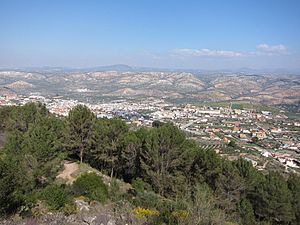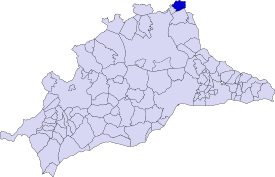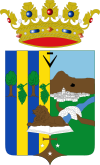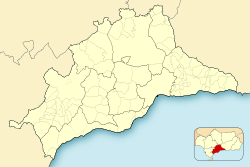Cuevas de San Marcos facts for kids
Quick facts for kids
Cuevas de San Marcos
|
||
|---|---|---|
 |
||
|
||
| Sovereign state | ||
| Autonomous community | ||
| Province | ||
| Comarca | Comarca de Antequera | |
| Area | ||
| • Total | 37 km2 (14 sq mi) | |
| Elevation | 422 m (1,385 ft) | |
| Population
(2018)
|
||
| • Total | 3,671 | |
| • Density | 99.2/km2 (257/sq mi) | |
| Demonym(s) | Cuevachos | |
| Time zone | UTC+1 (CET) | |
| • Summer (DST) | UTC+2 (CEST) | |
| Postal code |
29210
|
|
| Website | www.cuevasdesanmarcos.es | |
 |
||
Cuevas de San Marcos is a lovely town and municipality in southern Spain. It's part of the Málaga province in the region of Andalusia. This town is found in the northern part of the Antequera area, right on the border with the Córdoba province. It sits near the Genil river valley and the Sierra Malnombre mountains.
The town is about 420 meters (1,378 feet) above sea level. If you travel by road, Cuevas de San Marcos is 88 kilometers (55 miles) from the city of Málaga and 487 kilometers (303 miles) from Madrid. It's mainly a farming village, famous for growing olives and making olive oil, especially from a type called "Hojiblanca." The town's name comes from its patron saint, Mark the Evangelist, and its well-known Cave of Belda.
About 4,000 people live in Cuevas de San Marcos. The town covers an area of about 37.50 square kilometers (14.48 square miles). People from Cuevas de San Marcos are called Cuevachos.
Contents
Discovering Cuevas de San Marcos' Past
The story of Cuevas de San Marcos began in 1806. Before that, it was known as Cuevas Altas. It became its own independent town when it separated from Antequera, and that's when it got its current name. This town sits at the foot of the Sierra Camorro mountain range.
The Ancient City of Belda
Long ago, this area was known as Ciudad de Belda. It was located right at the base of a mountain where a famous cave, called Belda, is found. This cave is on the north side of the town and is part of the "Sierra del Camorro" mountain range. This mountain range is made of limestone and marl rocks from the Jurassic period and reaches a height of 907 meters (2,976 feet).
Secrets of the Belda Cave
At the very top of this mountain, archaeologists have found signs of human activity from the Paleolithic Age. This suggests that a castle and its forts might have once stood there, which were later destroyed by the Moors.
Inside the Belda Cave, there are at least three lakes and many galleries. These areas are filled with amazing stalactites that have formed over thousands of years. In the first lake, experts found remains of an ancient burial site. In the other two lakes, they discovered old pottery. You can see these fascinating finds at the City Museum or the Provincial Archaeological Museum.
See also
 In Spanish: Cuevas de San Marcos para niños
In Spanish: Cuevas de San Marcos para niños





